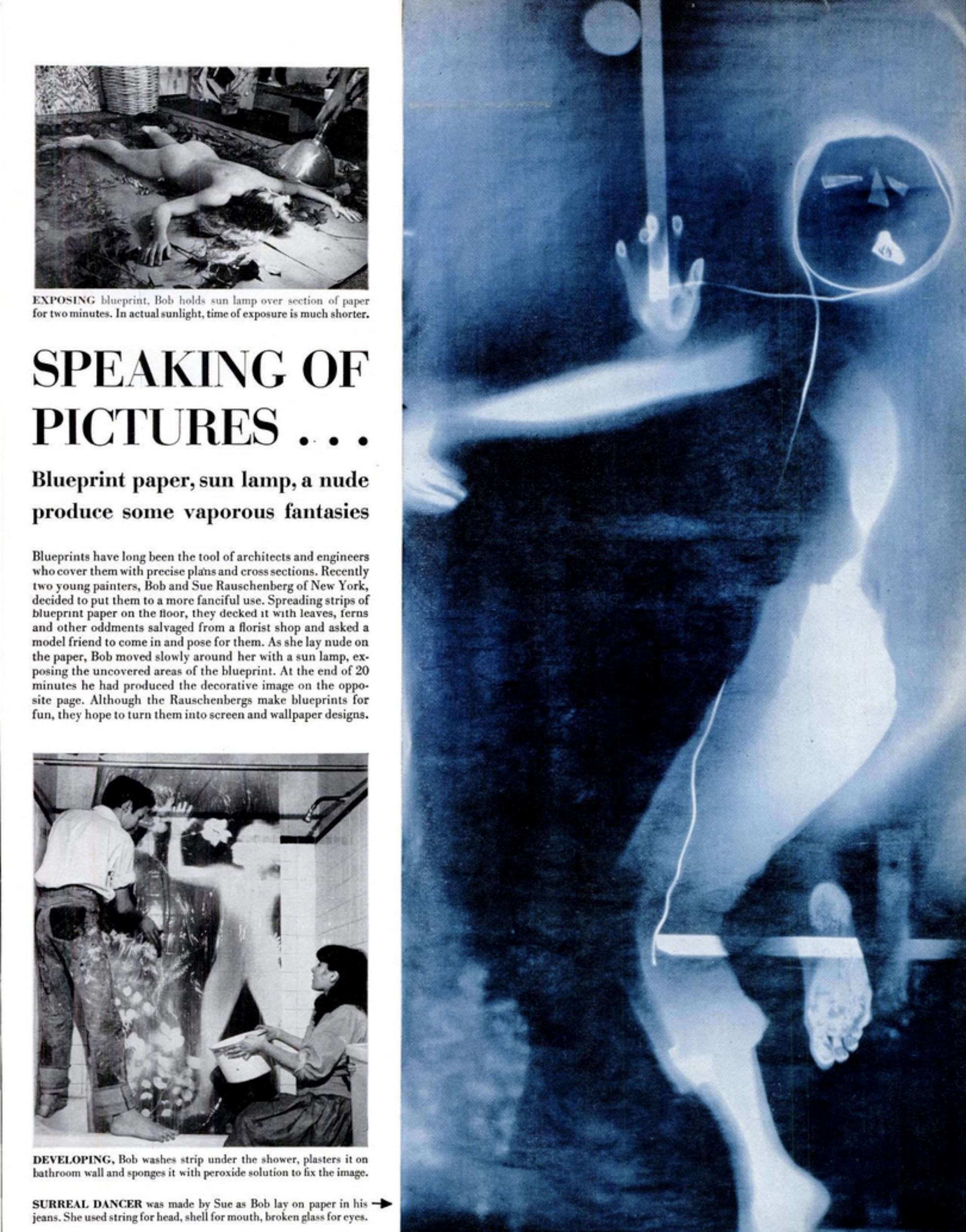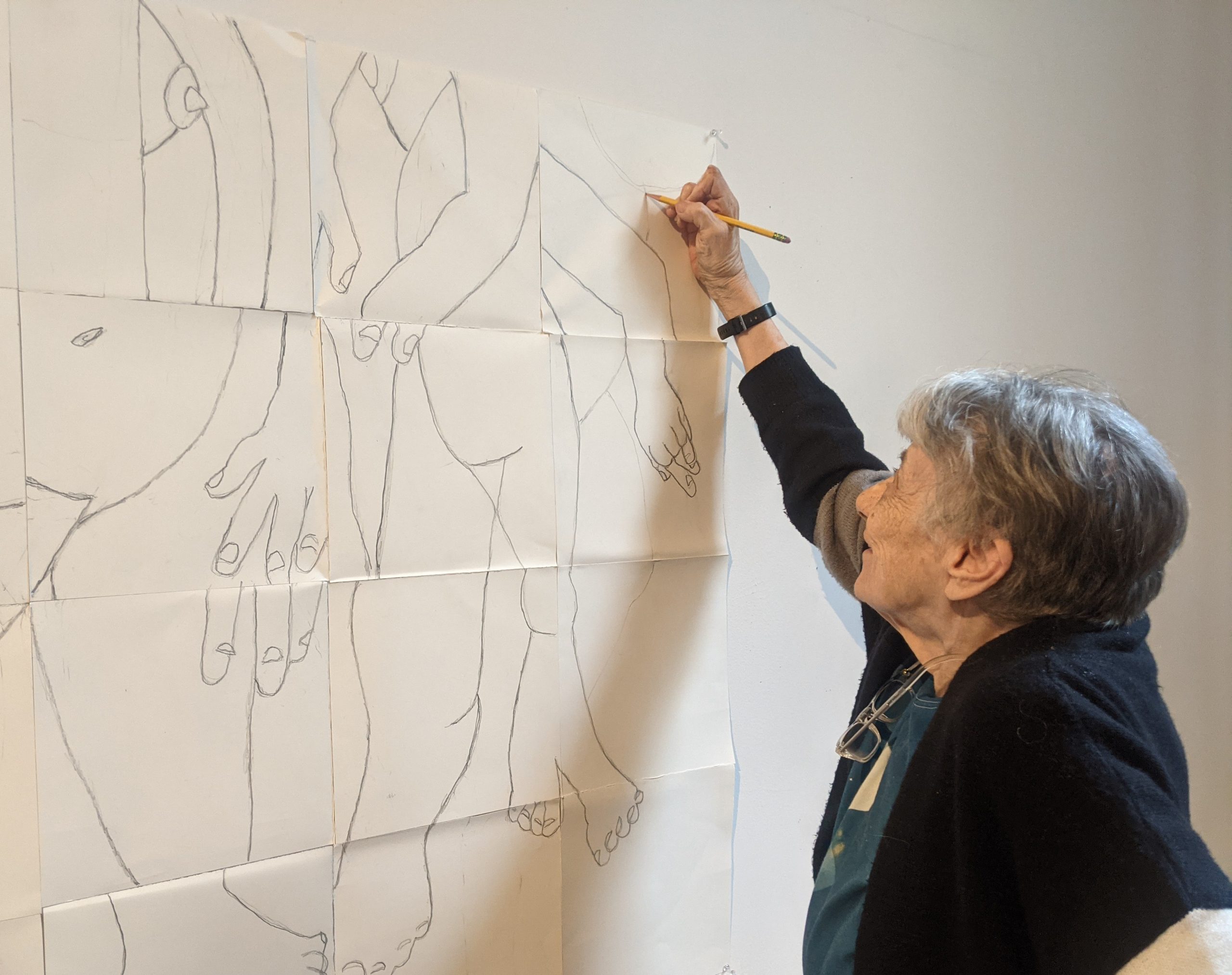The thing about Susan Weil is that, at 94 years old, her creative drive is relentless.
Several days a week, she travels from her home in downtown New York City to her studio in Williamsburg, Brooklyn, an airy space in a former yeshiva building that she has had for the past 60 years. On the days when Weil is not in the studio, she is drawing, pondering new works she’s planning, writing poems and making collages that she refers to as “Poemumbles” which she sends daily to her friends and family daily since the 1980s.
Weil’s quest for enchantment and delight within her artistic practice has been a clear source of inspiration since her days as a student under Josef Albers at Black Mountain College in the late 1940s. She never shied away from experimenting, and trusting where her intuition was going to lead her. Her work has taken on so many material forms: painting, drawing, sculpture, cyanotype, artist books, collaborations (with her then-husband Robert Rauschenberg, with photographer José Betancourt, and with renowned artist book publisher Vincent FitzGerald to name only a few).
Despite her radical sense of experimentation, there is a remarkable consistency present throughout Weil’s work over the past eight decades — eight decades! — that she has been a practicing artist. Central themes emerge, such as her fascination with the horizon line, the phases of the moon, movement of the body — quotidian subjects, yes, but subjects that embody the subtle ways in which we perceive the passing of time through space.

Susan Weil, Installation View, JDJ, 2024
This exhibition — JDJ’s third solo exhibition with Susan Weil — attempts to bring together a selection of works from different series throughout Weil’s mature years as an artist, from the 1960s through the present day.
The works on view span seventy years of Weil’s practice, and they demonstrate her rhizomatic conceptual approach, which does not fit neatly into a linear timeline. That the work is still unfolding, still developing and changing, remains remarkably impressive; for Weil, it’s just another day in the studio doing what she loves, exploring the world around her with a sense of intense curiosity and infectious joy.

Susan Weil, Installation View, JDJ, 2024
The earliest work in the exhibition, Walking Figure, 1968, feels firmly rooted in the visual language of pop art, with its colorful, spray-painted human form on top of Plexiglas. One can read this as a precursor for Weil’s subsequent interest in abstracting the human figure in many different series throughout the succeeding years.

Susan Weil, Walking Figure, 1968, Spray paint on Plexiglas sheet in open metal frame, 12 1/8 x 12 x 1 in
The spray paint on paper works from 1971–the subject of Weil’s first solo institutional exhibition at the University of North Carolina, School of Design, in Raleigh, NC—further abstract the body, breaking it down into fragments. These works articulate the silhouettes of body parts—the curve of a hip or breast, the crook of an elbow—and evoke a sense of corporeal fullness articulated through a minimal use of line and form.

Susan Weil, Installation View, JDJ, 2024

Susan Weil, Untitled, c. 1971, Spray paint on paper, 24 x 18 in
With Untitled, 1998, part of the Configurations series Weil produced in the 1990s and early 2000s, Weil paints several nude female figures on paper, cutting them into sections and collaging them one on top of another from largest to smallest. Taken as a whole, these paintings articulate a dynamic sense of movement reminiscent of the 19th century photographer Edwaerd Muybridge, whose ability to express passing time through its sequential moments is a source of inspiration for Weil. This concept is explored further in Sunbath, 2022, a nine-panel painting on canvas.

Susan Weil, Untitled, 1998, Acrylic, charcoal and watercolor on paper, 60 1/2 x 66 1/4 in

Susan Weil, Installation View, JDJ, 2024
In Floras, 1995, Weil’s depiction of parts of the body set against an opalescent painted background refers to some of the symbolic language present in the Irish poet and author James Joyce’s "A Portrait of the Artist as a Young Man". Weil has made countless works in reference to Joyce, whose experimental use of language and literary methods has been immensely influential to Weil.

Susan Weil, Installation View, JDJ, 2024

Susan Weil, Floras, 1995, Graphite, acrylic, and watercolor on paper, 15 x 15 1/4 in
About the author, Weil has said: “James Joyce’s writing is brilliant and the top writing in the world for me. My father was also a writer, and when I was a child he read us everything. I didn’t understand a thing but heard it as music. As an adult, to read the things I heard as a child and interpret them in my own way as a visual artist has been an absolute joy.”

Brideship & Gulls, 1991, By James Joyce (from Finnegans Wake), Etchings and original watercolors by Susan Weil, Publishing by Vincent Fitzgerald & Co
Literature and poetry are a critical part of her practice and inspire her object-based works as well as her many explorations into the world of language. Over the course of her career, she has created over a dozen artist books, and in 2011 established an imprint, Weil Books, which publishes the work of emerging and established artists, poets and writers. On view in this exhibition are a selection of handmade artist books Weil made in collaboration with the New York-based publisher Vincent Fitzgerald & Co. in the 1980s and 1990s.
The meticulously designed books, many of which unfurl into spectacular forms, pair Weil’s inventive vision with the works of writers such as Joyce, the American writer Gertrude Stein, and the 13th century Persian poet Rumi, among others.

Meta Mor For the Moon, 1994, Etching, cutting, painting, copper and gold leaf by Susan Weil, Published by Vincent FitzGerald & Co.

Tender Buttons, 1999, By Gertrude Stein, Etchings by Susan Weil, Published by Vincent Fitzgerald & Co
Such as with Floras, Weil uses reflective materials—opalescent and metallic paint, and even mirrored surfaces to reflect light and the viewer’s movement within space. Works such as the mirrored Plexiglas wall sculpture Realism, 2010, and the sixteen-panel painting on linen Shhh!, 2023, the most recent work in the exhibition, are exemplary of this technique. The latter—a series of target-like forms rendered in interference paint, shift from silvery white to pale lavender depending on one’s perspective.

Susan Weil, Realism, 2010, Lasercut mirrored plexi, 36 x 25 1/2 in

Susan Weil, Shhh!, 2023, Acrylic and linen on artist board, 49 1/2 x 49 1/2 in x 3/8
The form of the target can also be seen in Aswim, 2018, one work from a series of swimmers and bathers that began in the 1950s and has taken on many forms over the decades. The foreshortened body of the swimmer takes on an abstracted form, similar to what one can experience if standing on a dock, looking down at a swimmer in the water, with the water and reflected sunlight altering our perception of the figure below.

Susan Weil, Aswim, 2018, Acrylic and graphite on maple panels, 30 x 30 x 2 3/8 in
Weil grew up in the New York area, and, as a child, summered on one of the Thimble Islands in the Long Island Sound. She has described how the cycles of nature, such as the moon phases, and “sea and sky horizons have always made a powerful impression on me. I remember, as a child, trying to see the crisp horizon line as the curved edge of the earth.”
The horizon became an object of contemplation, a way of both capturing increments of time, and of considering our own bodies as tied to the land.

Susan Weil, Phases of the Moon, 1990, Acrylic on paper with staples and string, 28 x 12 in
In Soft Landscape, 1972, on view in this exhibition —the earliest work in this Soft Folds series of coiled, gathered, unstretched paintings on canvas made primarily from the 1970s-1990s—Weil has hung one of her paintings like a coat. By the pull of gravity, its folds obscure our view of the scenery to the point where the geography it depicts becomes the terrain of its own pleated surface, no longer painting as window onto a world, but a curtain. While the window may be gone, the horizon line remains.

Susan Weil, Soft Landscape, 1972, Acrylic on canvas, 72 x 9 x 4 in
Three decades of works in the Soft Folds series are represented in this exhibition, including Three Graces, 1986, a multi-entendre reference to Greek mythology, art history, and her mother; the punchy-yet-compact A Thought, 1984, reminiscent of a soft John Chamberlain sculpture, The 2012 work Tears, a collaboration with José Betancourt, combines a light silvery acrylic with a deep radiant blue achieved by using cyanotype solution.

Susan Weil, Three Graces, 1986, Acrylic on canvas, 66 x 46 1/2 x 14 1/2 in

Susan Weil, A Thought,, 1984, Acrylic on canvas, 26.3 x 11 in

Susan Weil and José Betancourt, Tears, 2012, Acrylic and cyanotype on canvas, 24 x 26 x 5 1/4 in
Weil’s fascination with cyanotype and blueprints is well documented and personal. She has written:
"Blueprints have been part of my life since I was a child. My brother and I used to make small blueprints of leaves, shells, paperclips, and any sort of object with an interesting silhouette.
The next chapter of my story: After high school I went to Paris to study art at the Academie Julien. I met Bob Rauschenberg there (I couldn’t have avoided if I wanted to, as we were staying in the same pension and going to the same art school). We shared the intensity about the long art story.
After summer I returned and went to Black Mountain College to study with Josef Albers. He was a professor in Germany’s Bauhaus, the exciting and irreverent school. Albers and his wife Anni were invited to teach at Black Mountain. It was a very art-oriented college. I was surprised when Bob R. appeared to study with Albers. We had a disciplined and exciting year there. Albers went on to teach at Yale. In the summer break Bob stayed with my family on their small island.
In Connecticut we painted a lot and explored other creative activities. Bob and I talked about my childhood blueprint fun. We went together to an architecture supply place and bought a full roll of unexposed blueprint paper. My younger brother Jim was the smallest person there, so we had him lie on the paper surrounded by seaweed, shells, stones, and made a blueprint. We fixed it with water and peroxide. The blues were deep and varied. That summer we made many more. We enjoyed the exploration very much.
In 1951 “Life” magazine printed an article and photograph about our blue journey. That was a wonderful event for two young artists!"

Susan Weil & Robert Rauschenberg, blueprints in Life magazine, 1951
Susan Weil was born in 1930 and lives and works in New York. Her work has been exhibited at institutions across the United States and Europe, including the Dallas Museum of Art, Dallas; Hammer Museum, Los Angeles; the Institute of Contemporary Art, Boston; Black Mountain College Museum + Art Center, Asheville, NC; and the Museo Reina Sofia, Madrid. Her work is included in a number of international museum and institutional collections, such as The Metropolitan Museum of Art, New York; The Museum of Modern Art, New York; Dallas Museum of Art, Dallas; The Menil Collection, Houston; The J. Paul Getty Museum, Los Angeles, and The Victoria and Albert Museum, London; and Moderna Museet, Stockholm among others.






















